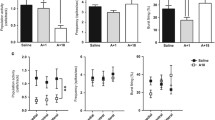Abstract
The effects of benzodiazepines, GABA and adenosine on distress-induced hyperemotionality and gastric lesion formation were investigated in rats. Hyperemotionality such as struggling, vocalization and defecation evoked immediately after immobilization stress were attenuated by diazepam, adenosine or adenosine plus diazepam. Conversely, pretreatment with these drugs produced rapid and potent exacerbation of gastric lesions observed after 12 h of stress. The potent adenosine A1-receptor agonist N6-cyclohexyl adenosine (CHA) markedly inhibited the distress-evoked hyperemotional behaviors and potentiated the ulceration. γ-Aminobutyric acid (GABA), muscimol, a GABA receptor agonist, and aminooxyacetic acid (AOAA), a GABA deaminase inhibitor, attenuated both stress-induced hyperemotionality and ulceration. The inhibitory effects of diazepam and GABA on hyperemotionality were reversed, respectively, by Ro15-1788, a benzodiazepine receptor antagonist, and bicuculline, a GABA receptor antagonist. The stimulatory effect of CHA on stress ulceration was potentiated by bicuculline but was not affected by Ro15-1788 or by picrotoxin, a chloride channel inhibitor. These results suggest that the mechanism involved in gastric lesion formation induced by immobilization stress may be different from that in hyperemotional behavior, and that the activation of GABAergic neurons may act as a central modulating factor in the hyperemotionality and ulceration induced by immobilization stress.
Similar content being viewed by others
References
Andrews PR, Johnston GAR (1979) GABA agonists and antagonists. Biochem Pharmacol 28:2697–2702
Bhargava KP, Daas M, Gupta GP, Gupta MB (1980) Study of central neurotransmitters in stress-induced gastric ulceration in albino rats. Br J Pharmacol 68:765–772
Bhargava KP, Gupta GP, Gupta MB (1985) Central GABA-ergic mechanism in stress-induced gastric ulceration. Br J Pharmacol 84:619–623
Birnbaum d (1969) The influence of psychotropic drugs on gastrointestinal function: experimental and clinical data. In: Pletscher A and Marino A (eds) Psychotropic drugs in internal medicine, Amsterdam: Excepta Medica Foundation, pp 101–108
Brown CM, Collis MG (1982) Evidence for an A/Ra adenosine receptor in the guinca-pig trachea. Br J Pharmacol 76:381–387
Costa E, Guidotti A (1979) Molecular mechanisms mediating the action of benzodiazepines. Ann Rev Pharmacol Toxicol 19:531–545
Dairman WM, Juhasz L (1978) A study in mice of benzodiazepine-anticholinergic interaction: Protection against restraint-immersion and forced exertion-induced gastric mucosal erosion. Pharmacology 17: 104–112
De Weid D (1976) Behavioral effects of intraventricularly administered vasopressin and vasopressin fragments. Life Sci 19:685–690
Duka T, Hollt V, Herz A (1979) In vivo receptor occupation by benzodiazepines and correlation with pharmacological effect. Brain Res 179:147–156
Enna SJ (1981) GABA receptor pharmacology: Functional considerations. Biochem Pharmacol 30:907–913
Enna SJ (1982) The role of neurotransmitters in the pharmacologic actions of Benzodiazepines. In: Mathew RJ (ed) The biology of anxiety, Brunner/Mazel, New York, pp 107–122
Feuerstein TJ, Hertting G, Jackisch R (1985) Modulation of hippocampal serotonin (5-HT) release by endogenous adenosine. Eur J Pharmacol 107:233–242
File SE (1980) The use of social interaction as a method for detecting anxiolotic activity of chlordiazepoxide-like drugs. J Neurosci Methods 2:219–238
File SE, Pearce JB (1981) Benzodiazepines reduced gastric ulcers induced in rats by stress. Br J Pharmacol 74:593–599
Glavin G (1982) Subject emotionality and coping responses as predisposing and precipitating factors in restraint ulcer in rats. In: Umehara S, Ito I (eds) Advances in experimental ulcer, Tokyo, Medical College Press pp 76–81
Gupta MB, Nath R, Gupta GP, Bhargava KP (1985) A study of the anti-ulcer activity of diazepam and other tranquillosedatives in albino rats. Clin Exp Pharmacol Physiol 12:61–66
Haefely W, Pieri L, Pole P, Schaffner R (1981) General pharmacology and neuropharmacology of benzodiazepine derivatives. In: Hoffmeister F, Stille (eds) Handbook of experimental pharmacology, Springer-Verlag, Heidelberg, pp 9–262
Haefely W, Polc P, Schaffner R, Keller HH, Pieri L, Mohler H (1979) Facilitation of GABAergic transmission of drugs. In: Krogsgaard-Larsen P, Scheel-Kruger J, Kofod H (eds) GABA-Neurotransmitters, Munksgaard, Copenhagen, pp 357–375
Jackisch R, Stritmatter H, Fehr R, Hertting G (1983) Modulation of hippocampal noradrenaline and acetylcholine release by endogenous adenosine. Naunyn-Schmiedeberg's Arch Pharmacol 324:R20
Möhler H, Okada T (1978) The benzodiazepine receptor in normal and pathological human brain. Br J Psychiatry 133:211–268
Phillis JW, Bender AS, Wu PH (1980) Benzodiazepines inhibit adenosine uptake into rat brain synaptosomes. Brain Res 195:494–498
Paton DM (1981) Structure-activity relations for presynaptic inhibition of noradrenergic and cholinergic transmission by adenosine. J Auton Pharmacol 1:287–290
Scatton B, Bartholini G (1982) γ-Aminobutyric acid (GABA) receptor stimulation IV. Effect of progabide (SL-76002) and other GABA-ergic agents on acetylcholine turnover in rat brain areas. J Pharmacol Exp Ther 220:689–695
Scatton B, Zivkovic B, Dekek J, Lloyd KG, Constantinidis J, Tissot R, Bartholini G (1982) γ-Aminobutyric acid (GABA) receptor stimulation III. Effect of progabide (SL 76002) on norepinephrine, dopamine and 5-hydroxytryptamine turnover in rat brain areas. J Pharmacol Exp Ther 220:678–688
Tanaka M, Kohno Y, Tsuda A, Nakagawa R, Ida Y, Iimori K, Hoaki Y, Nagasaki N (1983) Differential effects of morphine on noradrenaline release in brain regions of stressed and non-stressed rats. Brain Res 275:105–115
Ushijima I, Katsuragi T, Furukawa T (1984) Involvement of adenosine receptor activities in aggressive responses produced by clonidine in mice. Pschopharmacology 83:335–339
Ushijima I, Mizuki Y, Yamada M (1985) Development of stress-induced gastric lesions involves central adenosine A1-receptor stimulation. Brain Res 339:351–355
Vapaatalo H, Onken D, Neuvonen PJ, Westermann E (1975) Stereospecificity in some central and circulatory effects of phenylisopropyl adenosine (PIA). Arzneim Forsch 25:407–410
Author information
Authors and Affiliations
Rights and permissions
About this article
Cite this article
Ushijima, I., Mizuki, Y., Hara, T. et al. The role of adenosinergic, GABAergic and benzodiazepine systems in hyperemotionality and ulcer formation in stressed rats. Psychopharmacology 89, 472–476 (1986). https://doi.org/10.1007/BF02412124
Issue Date:
DOI: https://doi.org/10.1007/BF02412124




